Energy consumption when walking
Only a healthy and physically fit person can afford to actively engage in sports. Unlike strenuous, high-impact workouts, walking is less taxing on the body. Exercises help improve the functioning of the lungs and heart. Energy consumption when walking depends on the pace of movement and the athlete's metabolism. During a leisurely walk of 2-3 kilometers, up to 300 kilocalories are consumed. At a speed of 7 km/h you can burn up to 500 kcal. It is worth considering that without a properly selected diet, it will not be possible to achieve noticeable results.
Basic calorie cost table
And now we present to your attention a table of energy consumption for the most basic types of daily or sports activities:
| Types of physical work, activities | Calorie consumption, kcal/hour |
| Cooking | 80-82 |
| Dressing process | 28-30 |
| Driving a car | 50-55 |
| Wiping off dust and dirt | 80 |
| Eating | 30 |
| Work in the garden | 135 |
| Ironing clothes and clothes | 45-48 |
| Bed making | 130 |
| Shopping, walking around the store, supermarket | 80 |
| Sedentary work, including office work | 75 |
| Wood chopping | 280-300 |
| Floor washing, cleaning | 130 |
| Sex | 100-150 |
| Low or high intensity aerobic dancing | 215-500 |
| Badminton (low-intense pace) | 255-500 |
| Basketball | 400 |
| Cycling (9-20 or more km/h) | 185-550 |
| Gymnastics | 150 |
| Canoeing | 185 |
| Ballet | 750 |
| Ballroom dancing | 275-300 |
| Dancing to disco music | up to 400 |
| Modern dance | 250 |
| Football | 450 |
| Regular walking | 120-150 |
| Hiking (4 km/h) | 240-250 |
| Jumping using a skipping rope | 530-550 |
| Running (11 km/h) | 485 |
| Running up the stairs | 850-900 |
| Skiing | up to 500 |
| Downhill skiing | 270 |
| Ice skating | 700-750 |
| Swimming (speed) | 210-450 |
| Swimming fast crawl | 550 |
| Exercises in the gym | 520 |
Carefully study the calorie burning table and let it help you lose weight!
How many calories are spent walking?
During leisurely walks, a minimal amount of subcutaneous fat is consumed. Nevertheless, taking into account properly organized nutrition and daily routine, you can spend about 250 kilocalories per hour of exercise. Remember that energy expenditure depends on the terrain in which the workout takes place. Thus, the calorie consumption when walking on smooth asphalt is significantly inferior to exercise in the forest, where the terrain requires active movement. For this reason, experts recommend training in nature.
- Mayonnaise cookies: simple recipes
- Tongue salad: delicious recipes
- Eggplants with tomatoes and garlic for the winter - preparation. Recipes for eggplant salads for the winter with photos
How many calories are burned by walking in an hour?
Currently, there are special calculators that determine energy consumption for a particular type of load. On average, it is generally accepted that during a walk a person spends 3.2-3.8 kilocalories per kilogram of weight. The final result depends on many components. Thus, during exercise on rough terrain, up to 6.4 kcal is lost. More information about how many calories are burned per hour of walking can be found below:
- walk on a flat road – 200;
- uphill – 320;
- classes at an average pace - 335;
- climbing stairs – 500-700.
How many calories are burned when walking 1 km
Experts say that to lose weight you need to exercise regularly. It is important to cover a distance of at least 2-3 kilometers. Do not forget that before classes you need to do a short warm-up. This rule especially applies to athletes who prefer intense training in nature. You can calculate the number of calories burned when walking 1 km using a special calculator. Experienced athletes claim that about 100 kcal are spent.
How many calories are burned when walking 5 km
Energy consumption depends on the speed of movement. So, while walking at a slow pace, 300 kilocalories are burned. Losses will be more serious if you add aids in the form of special weights or dumbbells to your training. The calculator will help you calculate calories when walking more accurately, taking into account your weight, diet and training schedule. Remember that you need to start with short distance training. At first, you shouldn't be particularly interested in the number of calories burned when walking 5 km. Remember, such distances require preparation.
- How to remove fat from the sides quickly, exercises and diet. How to remove fat on the sides at home, video
- Corpus luteum cyst of the ovary: symptoms and treatment
- Radish - beneficial properties and contraindications for the body
What determines calorie consumption?
How many calories walking burns is a controversial question. And everything will depend on the following factors:
- Weight and height of a person.
- His physical fitness.
- Nutritional features.
- External conditions (weather, indoor environment with the treadmill and other factors).
- Clothes and shoes.
- Leg speed, extra arm work, etc.
These are the most significant and important factors that will determine your success in expending energy and getting rid of excess fat.
Another factor is the individual characteristics of your body: how much you sweat, what type of metabolism you have, how fast or slow this metabolism is. Every nuance will decide a lot. Some people will have to walk a lot to lose significant weight. And some will see the effect after several hours of training.
On the Internet you can find various figures showing how many calories are burned when walking 1 km. Please understand that these are average values. They are derived from massive experiments. At a minimum, you need to divide your calorie expenditure by weight category. The maximum is to individually calculate exactly your consumption, which is very difficult to do.
For example, a person weighing 50 kg will spend 184 kcal per hour, provided that he walks at a speed of 5 km per hour. And if his weight is 90 kg, then at the same speed the consumption will increase to 331 kcal! Let’s say the value will fluctuate by 30–50 kcal in both directions, depending on the above features.
https://youtu.be/gE77QOLntJM
How many calories are burned when walking up the stairs?
It is known that you can quickly lose excess weight by climbing up. Moreover, to perform this exercise you do not need to look for a hill or mountain. So, going up to the 9th floor may well replace these natural objects. The amount of calories burned when walking up the stairs is 1300 kcal. Remember not to exercise immediately after eating. It is best to conduct classes in the morning. At this time, burning calories when walking up the stairs will be more effective. Do not forget about a short warm-up before the “ascent”.
Walking on stairs for weight loss: benefits and reviews
Burning calories while walking is easily regulated by changing the pace, speed, step length, periodically switching to running, adding additional exercises (leg swings, walking with sticks, etc.).
The body is not overloaded from such activities. Endurance increases, heart function improves, blood vessels are strengthened. Calorie loss when walking is stable, easily calculated using special formulas, and predictable. Advantages over other physical activity options:
- Running puts stress on the spine and legs. Running is contraindicated for people with diseases of the musculoskeletal system, heart, and blood vessels.
- Swimming requires additional training and the purchase of a pool membership.
- Cycling is only suitable for those who have access to equipment. In addition, this sport is not recommended for people with bad knees.
In conditions of modern physical inactivity, the human body gradually moves from an acceptable motor mode to an unacceptably limited one, which leads to excess weight gain.
Daily walking on the stairs for weight loss, which involves slowly climbing the steps, will help burn extra calories and return your figure to its former parameters.
Learn how to perform this exercise correctly to achieve maximum results.
There is no consensus among professionals regarding the benefits of such activities for absolutely all people seeking to achieve an ideal body.
Walking up stairs to lose weight for an ordinary healthy person does not pose any danger, which cannot be said about people suffering from varicose veins in the legs and having injuries to the hip joints and knees.
For this group, active climbing of stairs is extremely harmful to health. For people without these pathologies, walking up stairs is even very useful. Lifting has the following effects:
- increases the elasticity of the thighs, calves, buttocks;
- reduces the risk of developing pathologies of the heart and blood vessels;
- helps increase muscle mass;
- increases daily calorie expenditure.
Walking up the steps to lose weight helps strengthen almost all organs and systems of the body. Climbing stairs at a fast pace helps to effectively work out your abs, back, and buttocks. Separately, it is worth mentioning the hips.
As a rule, when losing weight, this area is most susceptible to sagging, which can be avoided by climbing several flights of stairs every day.
At the same time, you can improve the result by using dumbbells and special weights during exercise.
It is known that walking up the stairs is even more effective for weight loss than light jogging. In addition, during a climb, a person burns calories 10 times more intensely than when moving on a flat surface.
It is important to note that energy is spent not only on the ascent, but also on the way back. When answering how many calories are burned when walking up the stairs, experts note that it all depends on the correctness and intensity of the training.
On average, you can burn up to 700 kcal in an hour of active exercise.
Each person should approach training individually, taking into account the parameters of their own body and its readiness for physical activity. In any case, it is better to start with short sessions. At the same time, do not forget about a light warm-up before walking up the stairs. In cases where there are minor health problems, you need to start with minimal loads.
At first, you should not highlight the obligatory ascent to the 9th floor on foot; it will be quite enough to climb 5 flights of stairs.
At first, it is not even forbidden to use the elevator periodically if walking up the stairs is difficult. The load should also be increased gradually, focusing on how you feel during training.
In addition, you need to pay special attention to your pulse: the optimal heart rate is between 140-150 beats per minute.
If you need to lose excess weight, it is advisable to do the exercise at an accelerated pace. You should exercise only in running shoes: this way you can prevent ankle injuries. With all this, in order to eliminate excess fat mass and give the body definition, you need to follow an extremely simple technique for walking up the steps:
- you need to climb calmly, overcoming each step step by step;
- the body must not be tilted to the side;
- the stomach should be pulled in while walking;
- It is recommended to perform movements with your hands that are typical for race walking;
- You can't hold on to the railing.
Climbing stairs
When choosing walking up stairs as a way to lose excess weight, do not forget that a slow pace helps maintain muscle tone, and a fast climb helps burn extra calories.
We invite you to read why green tea with jasmine should be drunk every day: 10 benefits
Regardless of how quickly you climb stairs, it is extremely important to monitor your heart rate. If your heart rate exceeds 150 beats per minute, you should think about reducing the intensity of your training.
It is important to note that walking on stairs for weight loss is contraindicated for persons with a body mass index of 30 and above.
During classes, do not forget about the basic rules and restrictions associated with performing the exercise. It is important to pay attention not only to the technique of ascent, but also descent.
When walking down the stairs to lose weight, the back of the thigh is involved in the work, so if you walk along the steps on your toes, you can more effectively strengthen this area. In addition, it is better to precede the descent with a short pause.
Returning to the starting point should not take less than 15 minutes.
People who prefer to work out in the gym speak very positively about this type of device. As a rule, imitation of walking on stairs for weight loss occurs through the so-called climber, but there may be other options with the name of the projectile.
This device looks extremely simple: two pipes with pedals and a time sensor. It is important to note that the climber is one of the most effective cardio equipment. Exercising on it helps you burn even more calories than jogging.
Other advantages of the climber include:
- development of the correct dynamic stereotype;
- absence of a “light phase”;
- reducing the risk of ankle injury;
- the opportunity to exercise in the comfortable conditions of the gym;
- the presence of handrails to help maintain balance.
You can train with this simple device at home. A stepper is essentially a mini apparatus consisting of two closely spaced pedals. At first, performing exercises on this unit is unusual and even dangerous.
Therefore, before exercising, make sure that you can maintain your balance while pressing the pedals. If this is difficult for you, try connecting harnesses to your training by threading them through special holes on the stepper.
This will make it easier to maintain balance, which will significantly increase the number of repetitions.
So, for active weight loss, it is recommended to conduct daily half-hour walking sessions on a stepper. In addition, it is important to follow a simple rule: do not eat an hour and a half before and after training.
With regular exercise, the result is visible after a week.
Reviews
Olga, 38 years old
I decided to regain my former volumes by walking up the stairs. We managed to do this after 10 days of intensive training. I trained in the park, not far from my house. At first it was difficult to do even 2-3 repetitions, but then the body got used to the load, and the process began.
Elena, 26 years old
The doctor advised me to take the stairs to strengthen my cardiovascular system. In addition to the fact that this exercise is good for health, it is also a great way to preserve your waistline. So, an hour of walking burns about 500 calories, which is equivalent to eating cutlets for lunch.
How many calories are burned during Nordic walking?
When walking with poles, energy costs double. Calorie consumption during Nordic walking over rough terrain can reach 800 kcal. Moving at a speed of 90-100 steps per minute allows you to lose up to 1000 kcal per hour of training. Increased expenditure of calories when walking with Nordic poles is achieved due to more beneficial redistribution of the load. So, during classes, the muscles of the arms, upper back, and legs are used. This reduces the load on the spine and hip joints.
How many calories are spent when walking fast?
While walking at a speed of about 90 steps per minute, up to 400 kcal are consumed. In this case, there is no need to travel tens of kilometers. You can find out for sure how many calories walking at a fast pace burns through an individual calculation of energy expenditure. It is important to consider that the walk should be carried out in a mode that is comfortable for the person. Exercise should be fun, and not make the athlete think about the number of calories spent walking fast. Novice athletes seem to forget about this, which often leads to all sorts of injuries and sprains.









